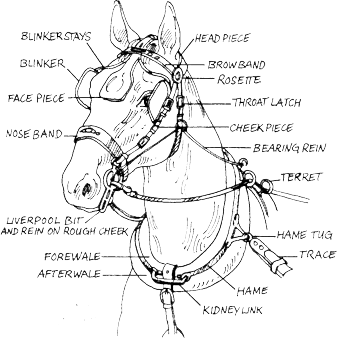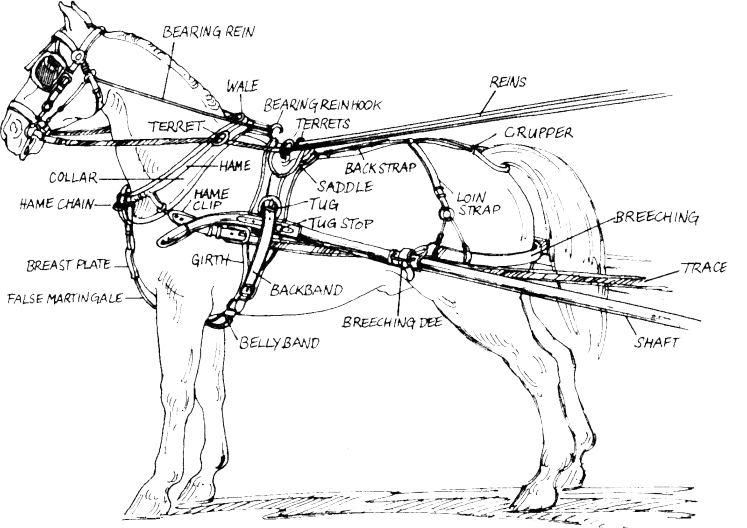Harness Parts
There are many styles of harness and it is important to correctly fit the harness to your pony along with properly matching it to the chosen vehicle you will be driving them with. A few of the harness parts can be referred to differently in draft driving compared to light horse/pony driving. Every great driver needs to know the parts of the pony and harness along with understanding the function of the 4 components of every harness in order to drive safely.
1. Communication Component
Bridle, bit and reins join the pony and driver together and allows each to communicate with the other.
This communication system can be complemented by the aid of a whip and your voice. The focal point of this communication system is a proper fitting bit held in place by a proper fitting bridle.
The driver is connected to the pony by the reins to give comfortable clear directions to the pony.
The brow band on the bridle prevent the crown piece from slipping down the poll.

The throat latch, with the help of the brow band, will help prevent the crown piece from slipping over the ears and coming off. A gullet strap may also be an additional safety part which would be added from the throat latch to the nose band.
Most driving bridles are equipped with winkers/blinkers/blinders to restrict the pony’s wide peripheral vision and help keep them focused on what is ahead. These blinders should be cupped and out far enough to avoid touching the eyelashes.
2. Draft Component
Breast collar and full collar can both be used for a single pony to pull a vehicle.
When pulling carts and buggy’s a breast collar is ideal as the draft line runs parallel with the shafts for the traces to hook up to the single tree.
When pulling heavier loads a full collar is the better choice as the weight is distributed throughout their shoulders compared to the weight being distributed just on the narrow band across the pony’s chest when using a breast collar. Also when using a full collar the correct draft line needs to be positioned at 90 degrees and in order to achieve this the single tree needs to be positioned towards the bottom of the vehicle.
An incorrect fitting of the breast collar and full collar can cause problems.
If a breast collar is too high it can press against the pony’s windpipe, and if it is too low that it is covering the point of shoulder it will interfere with the pony’s ability to travel freely and comfortably.
If a full collar doesn’t fit the pony right it can cause galls and soreness. If the full collar is the correct fit, but the draft line isn’t correct it can also cause pressure on the pony’s neck causing pain.
Traces / tugs attach to the breast collar/full collar with one end and to the vehicle with the other end to create the draught system which creates the forward motion.
Breast collar traces normally have slot ends that attach to the single tree on the vehicle where the full collar traces normally have heel chains. This is important to be able to safely match the type of harness that properly fits your pony to the specific vehicle you will be using.
3. Support Component
The Saddle is the main part of the vehicle support and guidance system. The shaft loops/shaft tugs are to hold the shafts from the vehicle in place at the proper height.
The pony steers the vehicle left or right by pushing into the saddle and shafts.
The top of the saddle has terrets which guide the reins and there is also a water hook that can attach an over check or side checks.
The saddle has a dee on the back to attach the back strap, which secures the crupper and hip strap/loin strap that holds up the breeching. The saddle is done up with the girth/belly band, and will have an overgirth/false belly band/ wrap strap/back band to keep the shafts from rising when the driver is mounting the cart, traveling uphill, stopping or reversing.
4. Braking Component
The breeching is attached to the vehicle by the hold back straps that pass through the footman loops on the shafts near the pony’s flank and then wrapped around the shafts. This stops the vehicle from running up on the pony’s rear when the vehicle is stopped and also aids the pony in reversing the vehicle.
In between the pony’s dock to hock is where the breeching should be adjusted. If it is too high it can ride up under the tail and if it’s too low it can inhibit the pony’s leg motion.

